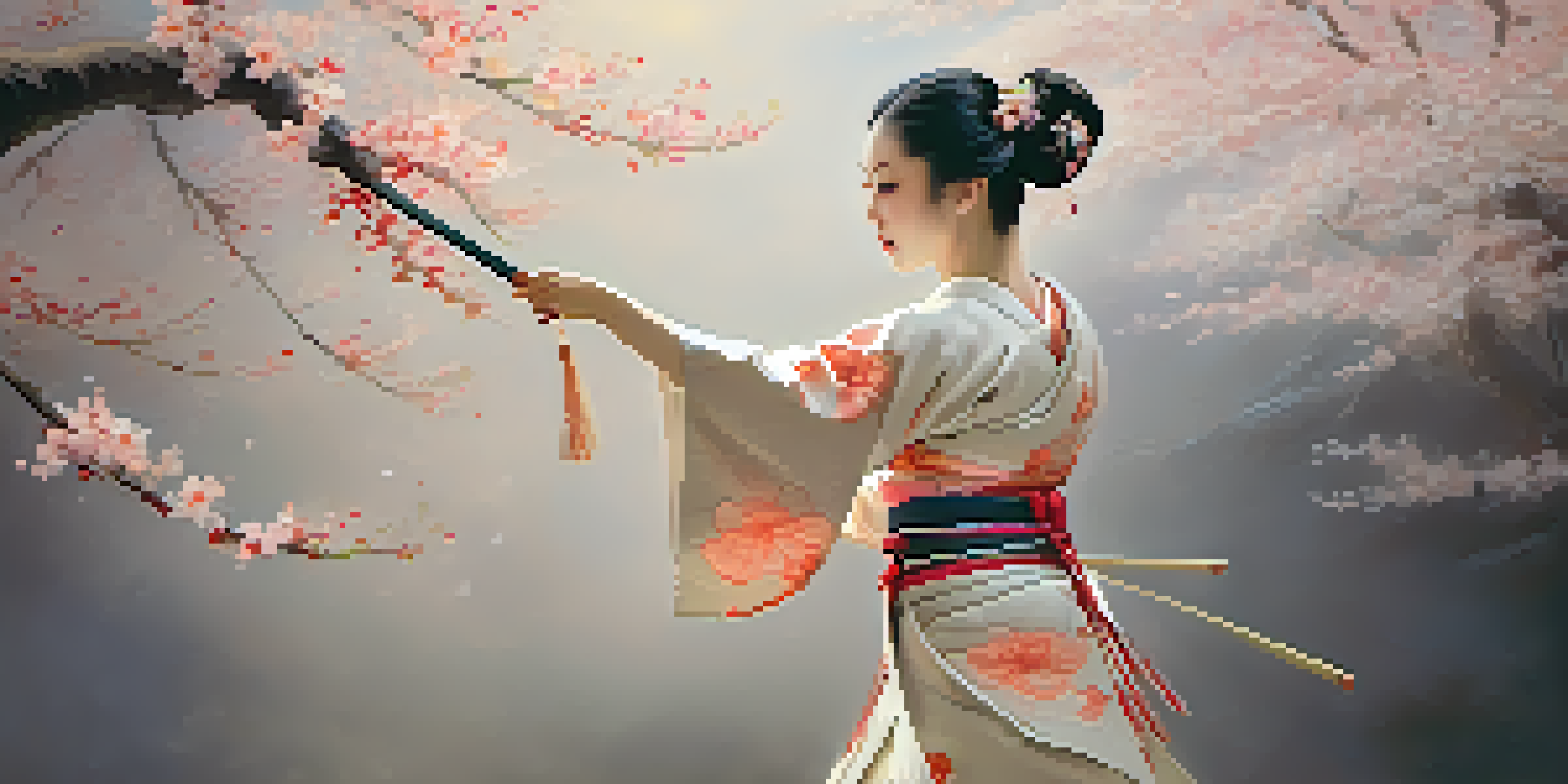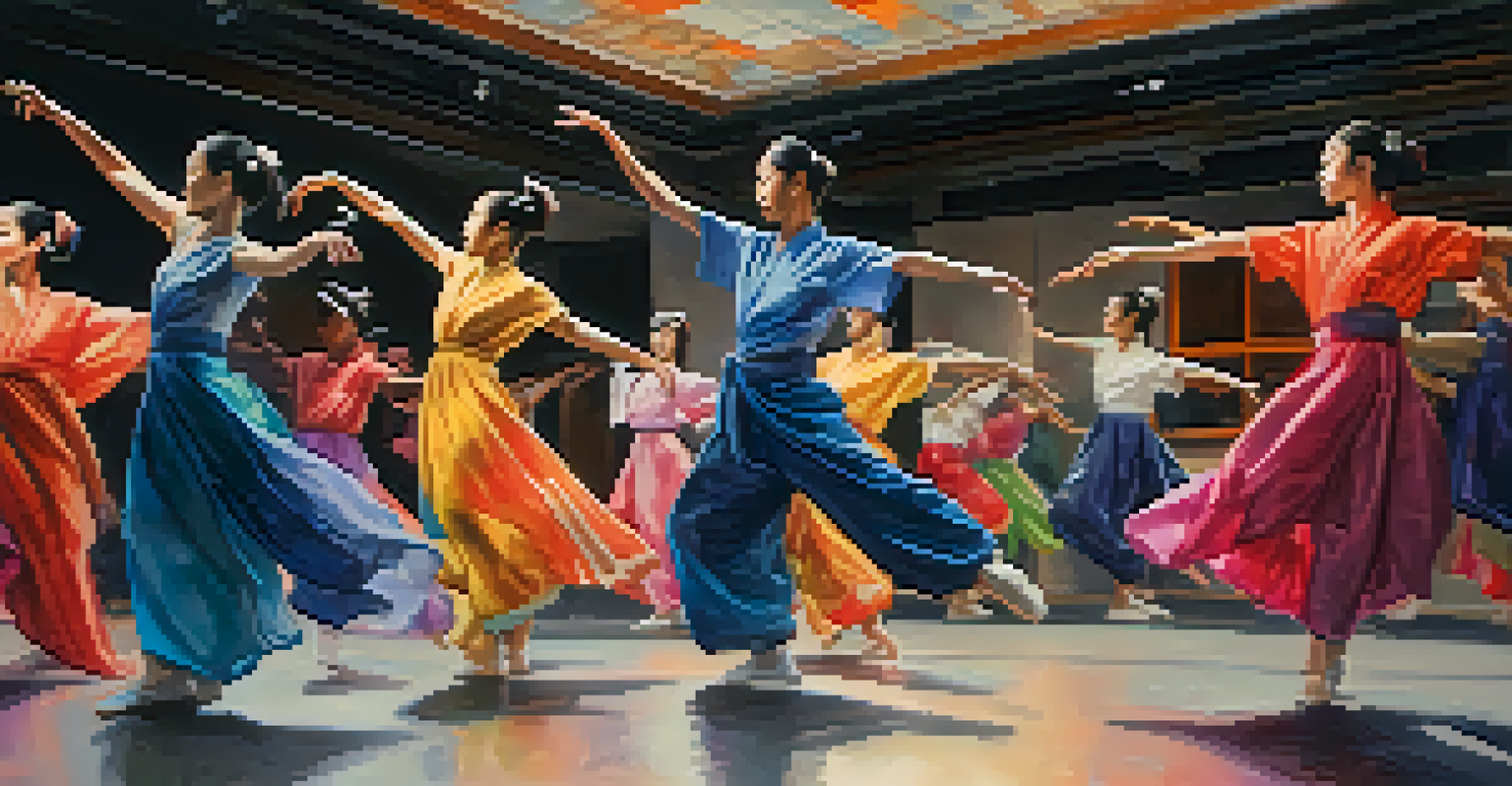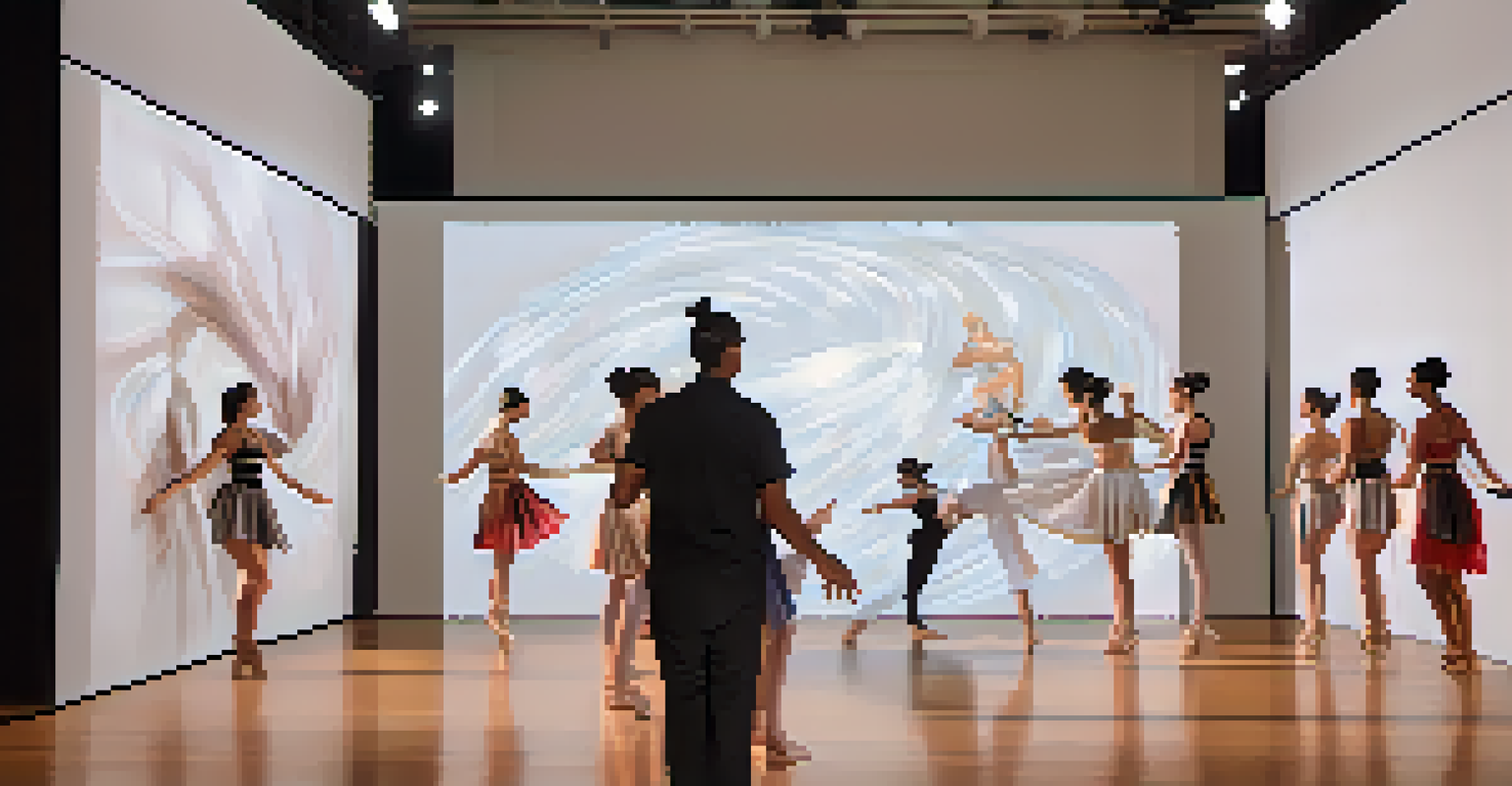Merging Traditional and Modern: The Case of Japanese Dance Forms

Understanding Traditional Japanese Dance Forms
Japanese traditional dance forms, such as Noh, Kabuki, and Odori, have rich histories that date back centuries. These art forms are not just performances; they are expressive narratives steeped in cultural significance. Each style has its unique characteristics, with Noh being known for its slow, stylized movements and Kabuki for its vibrant costumes and exaggerated expressions. Understanding these dance forms helps us appreciate their role in preserving Japan's cultural heritage.
Dance is the hidden language of the soul.
Moreover, traditional dances often tell stories from mythology, history, and everyday life, making them a vital part of Japan's storytelling tradition. For instance, the delicate movements of Noh can evoke deep emotions, while Kabuki's flamboyant style captivates audiences with its dynamic storytelling. This contrast highlights how traditional dance serves both as entertainment and a means of cultural expression.
As we delve into the evolution of these forms, it becomes clear that they are not static; they adapt and change over time. This adaptability sets the stage for the exciting fusion of traditional and modern elements that we see in contemporary Japanese dance.
The Rise of Contemporary Japanese Dance
Contemporary Japanese dance has evolved considerably since the late 20th century, embracing influences from Western dance styles like ballet and modern dance. This shift has opened doors for creativity, allowing artists to explore new themes, movements, and forms of expression. For example, choreographers like Akram Khan have blended traditional Japanese elements with contemporary dance, creating performances that resonate with both local and global audiences.

In this modern context, dance becomes a platform for dialogue, reflecting contemporary social issues, personal stories, and cultural identity. Dancers often incorporate multimedia and innovative staging techniques, making performances more immersive and engaging. This combination of tradition and innovation invites a broader audience to connect with Japanese culture in fresh ways.
Fusion of Tradition and Modernity
Japanese dance forms are evolving by blending traditional elements with contemporary styles, creating dynamic performances that resonate with diverse audiences.
Furthermore, contemporary dance encourages collaborations between dancers, musicians, and visual artists, creating a rich tapestry of artistic expression. These collaborations not only enhance the performance experience but also challenge the boundaries of what Japanese dance can be.
Key Figures in Merging Traditional and Modern Dance
Several influential figures have played pivotal roles in merging traditional and contemporary Japanese dance. One notable artist is Yoshiko Chuma, who has dedicated her career to blending various dance forms and creating unique works that reflect both her heritage and modern influences. Her innovative choreography often incorporates elements from Noh and Kabuki, showcasing a seamless integration of styles.
Tradition is not the worship of ashes, but the preservation of fire.
Another prominent figure is the renowned choreographer and dancer, Shunpuu Shimizu, who explores the intersections of tradition and modernity in her performances. Through her work, she emphasizes that traditional dance should not be viewed as antiquated but rather as a living, evolving art form. This perspective encourages younger generations to engage with and reinterpret traditional practices.
These artists, among many others, are critical in shaping the future of Japanese dance. By pushing the boundaries of creativity, they inspire a new wave of dancers to explore their cultural roots while embracing contemporary influences.
Audience Reception: Embracing the Fusion
As traditional and contemporary dance forms intersect, audience reception plays a crucial role in the evolution of these art forms. Many viewers appreciate the refreshing take on traditional elements, finding joy in the reinterpretation of familiar narratives. This blend not only captivates longtime fans of traditional dance but also attracts new audiences who may not have previously engaged with these art forms.
Moreover, the fusion of styles often sparks discussions about cultural identity and the significance of tradition in contemporary society. Audiences are increasingly aware of the importance of preserving cultural heritage while also recognizing the need for evolution. This awareness fosters a deeper appreciation for the art forms and encourages more people to participate in cultural events.
Technology Enhances Dance Experience
Innovative technology, including digital projections and social media, plays a crucial role in transforming Japanese dance and expanding its reach.
Ultimately, the merging of traditional and modern dance creates a dynamic dialogue between past and present, enriching the cultural landscape. This evolving relationship invites audiences to reflect on their own connections to tradition and modernity.
The Role of Technology in Dance Evolution
Technology has significantly impacted the evolution of Japanese dance, providing new tools for exploration and expression. From digital projections to innovative lighting techniques, technology enhances the visual aspects of performances, creating immersive experiences for audiences. These advancements allow choreographers to experiment with how they present traditional stories in a modern context.
Social media platforms have also become vital in sharing dance performances, reaching wider audiences, and promoting engagement. Dancers and choreographers utilize these platforms to showcase their work, gather feedback, and connect with fans globally. This accessibility helps bridge the gap between traditional dance forms and contemporary audiences, fostering a sense of community.
Additionally, technology enables collaboration among artists from diverse backgrounds, leading to unique fusions of styles. By incorporating various artistic elements, such as video art or interactive installations, dance becomes a multi-sensory experience that transcends cultural boundaries.
Challenges in Merging Dance Forms
Despite the exciting possibilities of merging traditional and modern dance, challenges remain in this artistic evolution. One significant hurdle is the preservation of traditional techniques and values amidst the push for innovation. Dancers must navigate the delicate balance of honoring their cultural roots while also embracing contemporary influences, which can sometimes lead to tensions within the artistic community.
Moreover, there is often a generational divide regarding how dance should be approached. Older practitioners may hold onto traditional practices with a sense of reverence, while younger dancers may feel compelled to break away and explore new directions. This divergence can create friction, as each group strives to validate its perspective on what Japanese dance should represent.
Challenges in Artistic Evolution
The merging of traditional and modern dance faces challenges, including the preservation of cultural techniques and generational divides among practitioners.
Additionally, funding and support for innovative projects can be limited, making it challenging for artists to pursue their creative visions. Overcoming these obstacles requires collaboration, open dialogue, and a mutual understanding of the importance of both tradition and modernity in the dance landscape.
The Future of Japanese Dance: A Harmonious Blend
Looking ahead, the future of Japanese dance seems bright as artists continue to explore the harmonious blend of traditional and contemporary forms. This fusion creates a vibrant landscape where creativity knows no bounds, inviting exploration and experimentation. As more artists engage with both styles, we can expect to see even more innovative performances that captivate and inspire audiences.
Moreover, the increasing global interest in Japanese culture encourages further exploration and collaboration. Artists from various backgrounds are likely to contribute their perspectives, enriching the dialogue surrounding Japanese dance and fostering a sense of unity through diversity. This cross-cultural exchange broadens the appeal of Japanese dance and ensures its relevance in a rapidly changing world.

Ultimately, the merging of traditional and modern dance forms not only preserves cultural heritage but also revitalizes it for future generations. As audiences continue to embrace this evolution, Japanese dance will undoubtedly flourish, reflecting the dynamic spirit of its people.